Evolution of Nb–Ta Oxide Minerals and Their Relationship to the Magmatic-Hydrothermal Processes of the Nb–Ta Mineralized Syenitic Dikes in the Panxi Region, SW China
Abstract
:1. Introduction
2. Geological Setting
3. Petrography
3.1. Mafic–Ultramafic Layered Intrusions
3.2. Nb–Ta Mineralized Syenitic Dikes
4. Materials and Methods
5. Results
5.1. Columbite-(Fe)
5.2. Fersmite
5.3. Fergusonite-(Y)
5.4. Pyrochlore Group Minerals
5.4.1. Pyrochlores I and II
5.4.2. Pyrochlore III
5.4.3. Pyrochlore IV
6. Discussion
6.1. The Generation of the Nb–Ta Oxide Minerals
6.2. The Generation of the Pyrochlore Supergroup Minerals
6.2.1. Crystal Chemistry of the Pyrochlore Supergroup Minerals
6.2.2. Pyrochlore Group Minerals Evolution vs. the Magmatic-Hydrothermal Evolution of the Syenitic Dikes
6.3. Two Stages of Crystallization of Nb–Ta Minerals in the Huili Syenite Dikes
6.3.1. Primary Magmatic Mineralization Stage
6.3.2. Fluid-Rich Mineralization Stage
6.4. Types of Minerals in the Different Types of Felsic Nb–Ta Deposits
7. Conclusions
Author Contributions
Funding
Acknowledgments
Conflicts of Interest
References
- Ballouard, C.; Massuyeau, M.; Elburg, M.A.; Tappe, S.; Viljoen, F.; Brandenburg, J.T. The magmatic and magmatic-hydrothermal evolution of felsic igneous rocks as seen through Nb-Ta geochemical fractionation, with implications for the origins of rare-metal mineralizations. Earth-Sci. Rev. 2020, 203, 103115. [Google Scholar] [CrossRef]
- Linnen, R.L.; Samson, I.M.; Williams-Jones, A.E.; Chakhmouradian, A.R. Geochemistry of the rare-earth element, Nb, Ta, Hf, and Zr deposits. In Treatise on Geochemistry, 2nd ed.; Scott, S.D., Ed.; Elsevier Science: Amsterdam, The Netherlands, 2014; pp. 543–568. [Google Scholar]
- Linnen, R.L.; Trueman, D.L.; Burt, R. Critical Metals Handbook; Gunn, G., Ed.; John Wiley & Sons: Hoboken, NJ, USA, 2014; pp. 361–384. [Google Scholar]
- Bonin, B. A-type granites and related rocks: Evolution of a concept, problems and prospects. Lithos 2007, 97, 1–29. [Google Scholar] [CrossRef]
- Collins, W.J.; Beams, S.D.; White, A.J.R.; Chappell, B.W. Nature and origin of A-type granites with particular reference to southeastern Australia. Contrib. Mineral. Petrol. 1982, 80, 189–200. [Google Scholar] [CrossRef]
- Whalen, J.B.; Currie, K.L.; Chappell, B.W. A-type granites: Geochemical characteristics, discrimination and petrogenesis. Contrib. Mineral. Petrol. 1987, 95, 407–419. [Google Scholar] [CrossRef]
- Černý, P.; Ercit, T.S. The classification of granitic pegmatites revisited. Can. Mineral. 2005, 43, 2005–2026. [Google Scholar] [CrossRef] [Green Version]
- Chakhmouradian, A.R.; Zaitsev, A.N. Rare earth mineralization in igneous rocks: Sources and processes. Elements 2012, 8, 347–353. [Google Scholar] [CrossRef]
- Linnen, R.L.; Cuney, M. Granite-related rare-element deposits and experimental constraints on Ta-Nb-W-Sn-Zr-Hf mineralization, in Linnen RL and Samson IM, eds., rare-element geochemistry and mineral deposits. Geol. Assoc. Can. GAC Short Course 2005, 17, 45–67. [Google Scholar]
- Linnen, R.L.; Keppler, H. Columbite solubility in granitic melts: Consequences for the enrichment and fractionation of Nb and Ta in the Earth’s crust. Contrib. Mineral. Petrol. 1997, 128, 213–227. [Google Scholar] [CrossRef]
- Linnen, R.L. The solubility of Nb-Ta-Zr-Hf-W in granitic melts with Li and Li + F; constraints for mineralization in rare metal granites and pegmatites. Econ. Geol. 1998, 93, 1013–1025. [Google Scholar] [CrossRef]
- Zhu, Z.Y.; Wang, R.C.; Marignac, C.; Cuney, M.; Lespinasse, M. Petrogenesis of Nb–(Ta) aplo-pegmatites and fine-grained granites from the Early Cretaceous Huangshan rare-metal granite suite, northeast Jiangxi Province, southeast China. Lithos 2019, 346–347, 105150. [Google Scholar] [CrossRef]
- Cuney, M.; Marignac, C.; Weisbrod, A. The Beauvoir topaz-lepidolite albite granite (Massif Central, France); the disseminated magmatic Sn-Li-Ta-Nb-Be mineralization. Econ. Geol. 1992, 87, 1766–1794. [Google Scholar] [CrossRef]
- Hildreth, W. The Bishop Tuff: Evidence for the origin of compositional zonation in silicic magma chambers. Geol. Soc. Am. Spec. Pap. 1979, 180, 43–75. [Google Scholar]
- Kovalenko, V.I.; Tasryeva, G.M.; Goreglyad, A.V.; Yarmolyuk, V.V.; Troitsky, V.A. The peralkaline granite-related Khaldzan-Buregtey rare metal (Zr, Nb, REE) deposit, western Mongolia. Econ. Geol. 1995, 90, 530–547. [Google Scholar] [CrossRef]
- Pollard, P.J. Geochemistry of granites associated with tantalum and niobium mineralization. In Lanthanides, Tantalum and Niobium; Möller, P.Č.P., Saupé, F., Eds.; Springer: Berlin/Heidelberg, Germany, 1989; pp. 145–168. [Google Scholar]
- Raimbault, L.; Cuney, M.; Azencott, C.; Duthou, J.L.; Joron, J.L. Geochemical evidence for a multistage magmatic genesis of Ta-Sn-Li mineralization in the granite at Beauvoir, French Massif Central. Econ. Geol. 1995, 90, 548–576. [Google Scholar] [CrossRef]
- Zhu, J.C.; Li, R.K.; Li, F.C.; Xiong, X.L.; Zhou, F.Y.; Huang, X.L. Topaz–albite granites and rare-metal mineralization in the Limu district, Guangxi Province, southeast China. Miner. Depos. 2001, 36, 393–405. [Google Scholar] [CrossRef]
- Kempe, U.; Gotze, J.; Dandar, S.; Habermann, D. Magmatic and metasomatic processes during formation of the Nb-Zr-REE deposits Khaldzan Buregte and Tsakhir (Mongolian Altai): Indications from a combined CL-SEM study. Mineral. Mag. 1999, 63, 165–177. [Google Scholar] [CrossRef]
- Salvi, S.; Williams-Jones, A.E. Alteration, HFSE mineralisation and hydrocarbon formation in peralkaline igneous systems: Insights from the Strange Lake Pluton, Canada. Lithos 2006, 91, 19–34. [Google Scholar] [CrossRef]
- Alexander, P.G.; Anthony, E.W.; Patrick, C. Lithogeochemical vectors for hydrothermal processes in the strange lake peralkaline granitic REE-Zr-Nb deposit. Econ. Geol. 2016, 111, 1241–1276. [Google Scholar]
- Beurlen, H.; Da Silva, M.R.R.; Thomas, R.; Soares, D.; Olivier, P. Nb–Ta–(Ti–Sn) oxide mineral chemistry as tracer of rare-element granitic pegmatite fractionation in the Borborema Province, Northeastern Brazil. Miner. Depos. 2008, 43, 207–228. [Google Scholar] [CrossRef] [Green Version]
- Breiter, K.; Korbelová, Z.; Chládek, Š.; Uher, P.; Knésl, I.; Rambousek, P.; Hönig, S.; Sesulka, V. Diversity of Ti–Sn–W–Nb–Ta oxide minerals in the classic granite-related magmatic–hydrothermal Cínovec/Zinnwald Sn–W–Li deposit (Czech Republic). Eur. J. Mineral. 2017, 29, 727–738. [Google Scholar] [CrossRef]
- Khromova, E.A.; Doroshkevich, A.G.; Sharygin, V.V.; Izbrodin, L.A. Compositional evolution of pyrochlore-group minerals in carbonatites of the Belaya Zima Pluton, Eastern Sayan. Geol. Ore Depos. 2017, 59, 752–764. [Google Scholar] [CrossRef]
- Rao, C.; Wang, R.C.; Hu, H.; Zhang, W.L. Complex internal textures in oxide minerals from the Nanping No. 31 dyke of granitic pegmatite, Fujian Province, southeastern China. Can. Mineral. 2009, 47, 1195–1212. [Google Scholar] [CrossRef]
- Van Lichtervelde, M.; Salvi, S.; Béziat, D.; Linnen, R. Textural features and chemical evolution in tantalum oxides: Magmatic versus hydrothermal origins for Ta mineralization in the Tanco Lower Pegmatite, Manitoba, Canada. Econ. Geol. 2007, 102, 257–276. [Google Scholar] [CrossRef]
- Zhu, Z.Y.; Wang, R.C.; Che, X.D.; Zhu, J.C.; Wei, X.L.; Huang, X.E. Magmatic–hydrothermal rare-element mineralization in the Songshugang granite (northeastern Jiangxi, China): Insights from an electron-microprobe study of Nb–Ta–Zr minerals. Ore Geol. Rev. 2015, 65, 749–760. [Google Scholar] [CrossRef]
- Anenburg, M.; Mavrogenes, J.A.; Frigo, C.; Wall, F. An experimental approach to examine fluid-melt interaction and mineralization in rare-metal pegmatites. Sci. Adv. 2020, 6, eabb6570. [Google Scholar] [CrossRef]
- Sami, M.; Mahdy, N.M.; Ntaflos, T.; Fathy, D. Composition and origin of Ti–Nb–Ta–Zr bearing minerals in the abu diab highly evolved granite from the Central Eastern Desert of Egypt. J. Afr. Earth Sci. 2020, 165, 103808. [Google Scholar] [CrossRef]
- Carl, S.; Caitlin, M. Geology and genesis of the Toongi rare metal (Zr, Hf, Nb, Ta, Y and REE) deposit, NSW, Australia, and implications for rare metal mineralization in peralkaline igneous rocks. Contrib. Mineral. Petrol. 2016, 171, 104. [Google Scholar]
- Atencio, D.; Andrade, M.B.; Christy, A.G.; Giere, R.; Kartashov, P.M. The pyrochlore supergroup of minerals: Nomenclature. Can. Mineral. 2010, 48, 673–698. [Google Scholar] [CrossRef]
- Jamie, A.M.; Adrian, A.F.; Donald, A.H.; Ashlyn, A.B. Geochemistry of pyrochlore minerals from the Motzfeldt Center, South Greenland: The mineralogy of a syenite-hosted Ta, Nb deposit. Am. Mineral. 2013, 98, 426–438. [Google Scholar]
- Walter, B.F.; Parsapoor, A.; Braunger, S.; Marks, M.A. Pyrochlore as a monitor for magmatic and hydrothermal processes in carbonatites from the Kaiserstuhl volcanic complex (SW Germany). Chem. Geol. 2018, 498, 1–16. [Google Scholar] [CrossRef]
- Yan, D.P.; Zhou, M.F.; Song, H.L.; Wang, X.W.; Malpas, J. Origin and tectonic significance of a Mesozoic multi-layer over-thrust system within the Yangtze Block (South China). Tectonophysics 2003, 361, 239–254. [Google Scholar] [CrossRef]
- Wang, C.Y.; Zhou, M.F.; Zhao, D.G. Fe–Ti–Cr oxides from the Permian Xinjie mafic–ultramafic layered intrusion in the Emeishan large igneous province, SW China: Crystallization from Fe-and Ti-rich basaltic magmas. Lithos 2008, 102, 198–217. [Google Scholar] [CrossRef]
- Shellnutt, J.G.; Iizuka, Y. Oxidation zonation within the Emeishan large igneous province: Evidence from mantle-derived syenitic plutons. J. Asian Earth Sci. 2012, 54, 31–40. [Google Scholar] [CrossRef]
- Chung, S.L.; Jahn, B.M. Plume-lithosphere interaction in generation of the Emeishan flood basalts at the Permian-Triassic boundary. Geol. Fujian 1995, 23, 889–892. [Google Scholar] [CrossRef]
- He, J.L. Ore-forming Geological Conditions and Prospecting Potential for Nb-Ta Mineral Deposits in Panzhihua-Xichang Region, Sichuan. Acta Geol. Sichuan 2004, 4, 206–211. [Google Scholar]
- Pang, K.N.; Li, C.; Zhou, M.F.; Ripley, E.M. Mineral compositional constraints on petrogenesis and oxide ore genesis of the late Permian Panzhihua layered gabbroic intrusion, SW China. Lithos 2009, 110, 199–214. [Google Scholar] [CrossRef]
- Xing, C.M.; Wang, C.Y.; Zhang, M.J. Volatile and CHO isotopic compositions of giant Fe-Ti-V oxide deposits in the Panxi region and their implications for the sources of volatiles and the origin of Fe-Ti oxide ores. Sci. China Earth Sci. 2012, 55, 1782–1795. [Google Scholar] [CrossRef]
- Zhong, H.; Zhu, W.G.; Chu, Z.Y.; He, D.F.; Song, X.Y. SHRIMP U–Pb zircon geochronology, geochemistry, and Nd–Sr isotopic study of contrasting granites in the Emeishan large igneous province, SW China. Chem. Geol. 2007, 236, 112–133. [Google Scholar] [CrossRef]
- Xu, Y.G.; Luo, Z.Y.; Huang, X.L.; He, B.; Xiao, L.; Xie, L.W.; Shi, Y.R. Zircon U–Pb and Hf isotope constraints on crustal melting associated with the Emeishan mantle plume. Geochim. Cosmochim. Acta 2008, 72, 3084–3104. [Google Scholar] [CrossRef]
- Coffifin, M.F.; Eldholm, O. Large igneous provinces: Crustal structure, dimensions, and external consequences. Rev. Geophys. 1994, 32, 1–36. [Google Scholar] [CrossRef]
- Jerram, D.A.; Widdowson, M. The anatomy of Continental Flood Basalt Provinces: Geological constraints on the processes and products of flood volcanism. Lithos 2005, 79, 385–405. [Google Scholar] [CrossRef]
- Shellnutt, J.G.; Wang, C.Y.; Zhou, M.F.; Yang, Y.H. Zircon Lu–Hf isotopic compositions of metaluminous and peralkaline A-type granitic plutons of the Emeishan large igneous province (SW China): Constraints on the mantle source. J. Asian Earth Sci. 2009, 35, 45–55. [Google Scholar] [CrossRef]
- Xu, Y.G.; Chung, S.L.; Jahn, B.M.; Wu, G.Y. Petrologic and geochemical constraints on the petrogenesis of Permian–Triassic Emeishan flood basalts in southwestern China. Lithos 2001, 58, 145–168. [Google Scholar] [CrossRef]
- Zhou, M.F.; Yan, D.P.; Kennedy, A.K.; Li, Y.Q.; Ding, J. SHRIMP U–Pb zircon geochronological and geochemical evidence for Neoproterozoic arc-magmatism along the western margin of the Yangtze Block, South China. Earth Planet. Sci. Lett. 2002, 196, 51–67. [Google Scholar] [CrossRef]
- Xiao, L.; Pirajno, F.; He, Q. A preliminary discussion on large igneous provinces and associated ore deposits. Geol. J. China Univ. 2007, 13, 148. [Google Scholar]
- Li, W.Y.; Niu, Y.L.; Zhang, Z.W.; Zhang, M.J.; Gao, Y.B.; Hu, P.Q.; Zhang, J.W.; Tan, W.T.; Jiang, H.B. Geodynamic setting and further exploration of magmatism related mineralization concentrated in the Late Paleozoic in the northern Xinjiang Autonomous Region. Earth Sci. Front. 2012, 19, 41. [Google Scholar]
- Wang, F.L.; Zhao, T.P.; Chen, W. Advances in study of Nb-Ta ore deposits in Panxi area and tentative discussion on genesis of these ore deposits. Miner. Depos. 2012, 31, 293–308. [Google Scholar]
- Zhang, A.C.; Wang, R.C.; Hu, H.; Zhang, H.; Zhu, J.C.; Xie, L. The complex zonation of columbite-group minerals from the Koktokay No. 3 granitic pegmatite dyke, Altay, NW China and its petrological implications. Acta Geol. Sin. 2004, 2, 181–189. [Google Scholar]
- Wang, F.L.; Zhao, T.P.; Chen, T.W.; Wang, Y. Zircon U–Pb ages and Lu–Hf isotopic compositions of the Nb–Ta–Zr-bearing syenitic dikes in the Emeishan large igneous province. Acta Petrol. Sin. 2013, 29, 3519–3532. [Google Scholar]
- Yang, Z.S.; Duan, H.M.; Wang, X.J. Geological features and range of reconnaissance of Nb-Ta deposits in the Panzhihua-Xichang Region, Sichuan. Acta Geol. Sichuan 2007, 27, 248–254. [Google Scholar]
- Wang, F.L.; Zhao, T.P.; Wang, Y. Petrogenisis of Permian Nb–Ta mineralized syenitic dikes in the Panxi district, SW China. Acta Petrol. Sin. 2015, 31, 1797–1805. [Google Scholar]
- Xichang Geological Team in the Sichuan Bureau of Geology. The Lecture of Detail Exploration about Baicao Nb, Ta Deposit in the Panxi Region; Unpublished work; 1962. [Google Scholar]
- Liu, J.D.; Zhang, C.J.; Li, Y.G.; Liu, X.F.; Yang, Z.X.; Ma, X.Y.; Kan, Z.Z.; Chen, C.D. Metallization Systems in the Panzhihua-Xichang area of Sichuan, China; Geological Publishing House: Beijing, China, 2007. [Google Scholar]
- Wei, B.; Wang, C.Y.; Zhao, Z.; Bao, H. Columbite-group minerals and mica of peraluminous granite record the magmatic-hydrothermal processes that formed the Zhaojinggou TaNb deposit in the North China Craton. Lithos 2020, 370, 105648. [Google Scholar] [CrossRef]
- Wu, H.; Huang, H.; Zhang, Z.; Wang, T.; Wang, W. Geochronology, geochemistry, mineralogy and metallogenic implications of the Zhaojinggou Nb-Ta deposit in the northern margin of the North China Craton, China. Ore Geol. Rev. 2020, 125, 103692. [Google Scholar] [CrossRef]
- Lv, Z.H.; Chen, J.; Zhang, H.; Tang, Y. Petrogenesis of Neoproterozoic rare metal granite-pegmatite suite in Jiangnan Orogen and its implications for rare metal mineralization of peraluminous rock in South China. Ore Geol. Rev. 2020, 128, 103923. [Google Scholar] [CrossRef]
- Lumpkin, G.R.; Ewing, R.C. Geochemical alteration of pyrochlore group minerals: Pyrochlore subgroup. Am. Mineral. 1995, 80, 732–743. [Google Scholar] [CrossRef]
- Christy, A.G.; Atencio, D. Clarification of status of species in the pyrochlore supergroup. Mineral. Mag. 2013, 77, 13–20. [Google Scholar] [CrossRef]
- Hogarth, D.D.; Williams, C.T.; Jones, P. Primary zoning in pyrochlore group minerals from carbonatites. Mineral. Mag. 2000, 64, 683–697. [Google Scholar] [CrossRef]
- Hogarth, D.D. Classification and nomenclature of the pyrochlore group. Am. Mineral. 1977, 62, 403–410. [Google Scholar]
- Wang, Y.R.; Li, J.T.; Lu, J.L.; Fan, W.L. Geochemical mechanism of Nb-, Ta-mineralization during the late stage of granite crystallization. Geochemistry 1982, 1, 175–185. [Google Scholar]
- Nasraoui, M.; Bilal, E. Pyrochlores from the Lueshe carbonatite complex (Democratic Republic of Congo): A geochemical record of different alteration stages. J. Asian Earth Sci. 2000, 18, 237–251. [Google Scholar] [CrossRef]
- Williams, C.T.; Wall, F.; Woolley, A.R.; Phillipo, S. Compositional variation in pyrochlore from the Bingo carbonatite, Zaire. J. Afr. Earth Sci. 1997, 25, 137–145. [Google Scholar] [CrossRef]
- Bonazzi, P.; Bindi, L.; Zoppi, M.; Capitani, G.C.; Olmi, F. Single-crystal diffraction and transmission electron microscopy studies of “silicified” pyrochlore from Narssârssuk, Julianehaab district, Greenland. Am. Mineral. 2006, 91, 794–801. [Google Scholar] [CrossRef]
- Bakker, J.; Elburg, M.A. A magmatic-hydrothermal transition in Arkaroola (northern Flinders Ranges, South Australia): From diopside–titanite pegmatites to hematite–quartz growth. Contrib. Mineral. Petrol. 2006, 152, 541–569. [Google Scholar] [CrossRef]
- Jago, B.C.; Gittins, J. Pyrochlore crystallization in carbonatites: The role of fluorine. S. Afr. J. Geol. 1993, 96, 149–160. [Google Scholar]
- Mitchell, R.H.; Kjarsgaard, B.A. Solubility of niobium in the system CaCO3–Ca(OH)2–NaNbO3 at 0.1 GPa pressure. Contrib. Mineral. Petrol. 2002, 144, 93–97. [Google Scholar] [CrossRef]
- Simons, B.; Andersen, J.C.Ø.; Shail, R.K.; Jenner, F.E. Fractionation of Li, Be, Ga, Nb, Ta, In, Sn, Sb, W and Bi in the peraluminous early permian Variscan granites of the Cornubian Batholith: Precursor processes to magmatic-hydrothermal mineralisation. Lithos 2017, 278, 491–512. [Google Scholar] [CrossRef]
- Barsanov, G.P.; Yeremin, N.I.; Sergeyeva, N.Y.E. Columbite-tantalite zoning as revealed by electron-probe microanalysis. Dokl. Akad. Nauk SSSR 1971, 201, 174–176. [Google Scholar]
- Norton, D.I.; Dutrow, B.L. Complex behavior of magma-hydrothermal processes: Role of supercritical fluid. Geochim. Cosmochim. Acta 2001, 65, 4009–4017. [Google Scholar] [CrossRef]
- Zaraisky, G.P.; Korzhinskaya, V.; Kotova, N. Experimental studies of Ta2O5 and columbite–tantalite solubility in fluoride solutions from 300 to 550 °C and 50 to 100 MPa. Mineral. Petrol. 2010, 9, 287–300. [Google Scholar] [CrossRef]
- Knudsen, C. Pyrochlore group minerals from the Qaqarssuk carbonatite complex. In Lanthanides, Tantalum and Niobium; Möller, P.Č.P., Saupé, F., Eds.; Springer: Berlin/Heidelberg, Germany, 1989; pp. 80–99. [Google Scholar]
- Kjarsgaard, B.A.; Mitchell, R.H. Solubility of Ta in the system CaCO3–Ca(OH)2–NaTaO3–NaNbO3 ± F at 0.1 GPa: Implications for the crystallization of pyrochlore-group minerals in carbonatites. Can. Mineral. 2008, 46, 981–990. [Google Scholar] [CrossRef]
- Mitchell, R.H.; Kjarsgaard, B.A. Solubility of niobium in the system CaCO3–CaF2–NaNbO3 at 0.1 GPa pressure: Implications for the crystallization of pyrochlore from carbonatite magma. Contrib. Mineral. Petrol. 2004, 148, 281–287. [Google Scholar] [CrossRef]
- Stepanov AMavrogenes, J.A.; Meffre, S.; Davidson, P. The key role of mica during igneous concentration of tantalum. Contrib. Mineral. Petrol. 2014, 167, 1009. [Google Scholar] [CrossRef]
- Wang, R.C. Study on pyrochlore–group minerals from the Beauvoir granite, France. Acta Petrol. Mineral. 1994, 2, 140–148. [Google Scholar]
- Xiong, X.L.; Zhao, Z.H.; Zhu, J.C.; Rao, B.; Lai, M.Y. Partitioning of F between aqueous fluids and albite granite melt and its petrogenetic and metallogenetic significance. Chin. J. Geochem. 1998, 17, 303–310. [Google Scholar]
- Lin, Y.; Pollard, P.J.; Hu, S.Y.; Taylor, R.G. Geologic and geochemical characteristics of the Yichun Ta-Nb-Li deposit, Jiangxi Province, South China. Econ. Geol. 1995, 90, 577–585. [Google Scholar] [CrossRef]
- Wang, W.Y.; Yang, Y.Q.; Chen, C.H.; Zhu, J.H. Study on the Nb and Ta–minerals from the granitic pegmatites in Nanping, Fujian Province. Geol. Fujian 1999, 2, 22. [Google Scholar]
- Keppler, H. Influence of fluorine on the enrichment of high field strength trace elements in granitic rocks. Contrib. Mineral. Petrol. 1993, 114, 479–488. [Google Scholar] [CrossRef]
- Mikhailova, J.A.; Pakhomovsky, Y.A.; Ivanyuk, G.Y.; Bazai, A.V.; Yakovenchuk, V.N.; Elizarova, I.R.; Kalashnikov, A.O. REE mineralogy and geochemistry of the Western Keivy peralkaline granite massif, Kola Peninsula, Russia. Ore Geol. Rev. 2017, 82, 181–197. [Google Scholar] [CrossRef]
- Feng, S.Z. Geological characteristic and ore genesis of rare metal and rare-earth ore deposit in Baerze alkalic granite, Inner Mongolia. Volcanol. Miner. Resour. 2000, 21, 137–142. [Google Scholar]
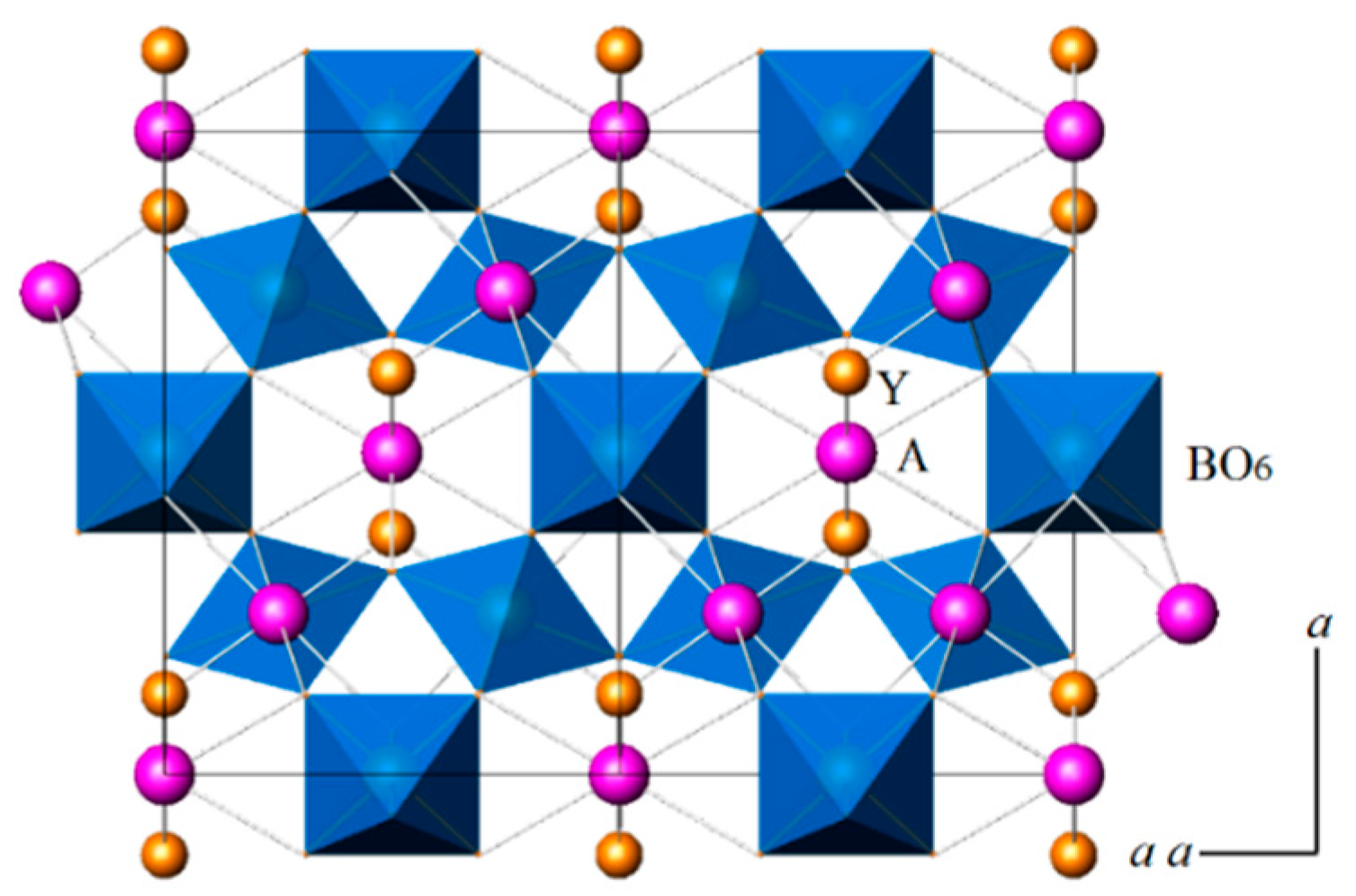
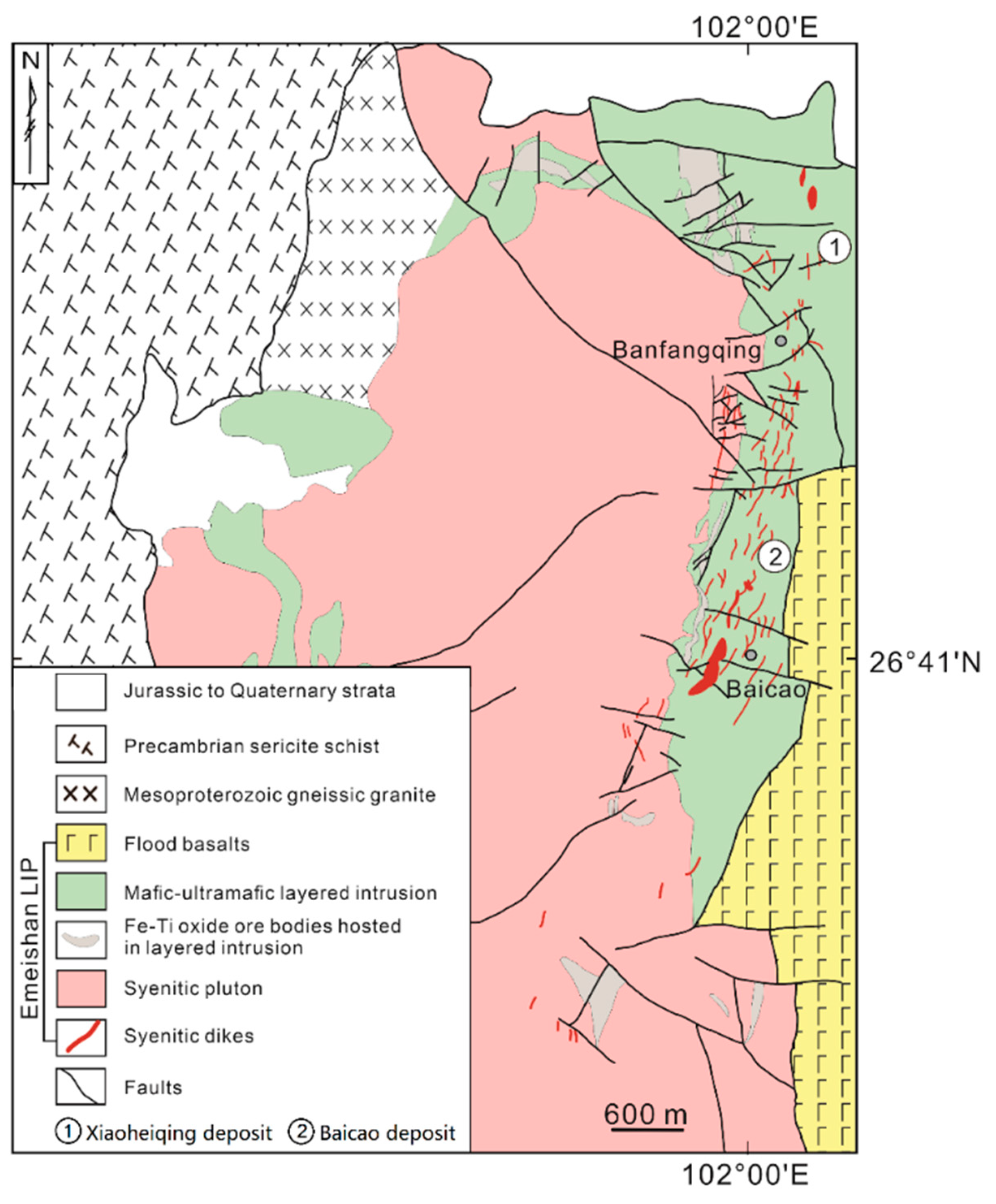

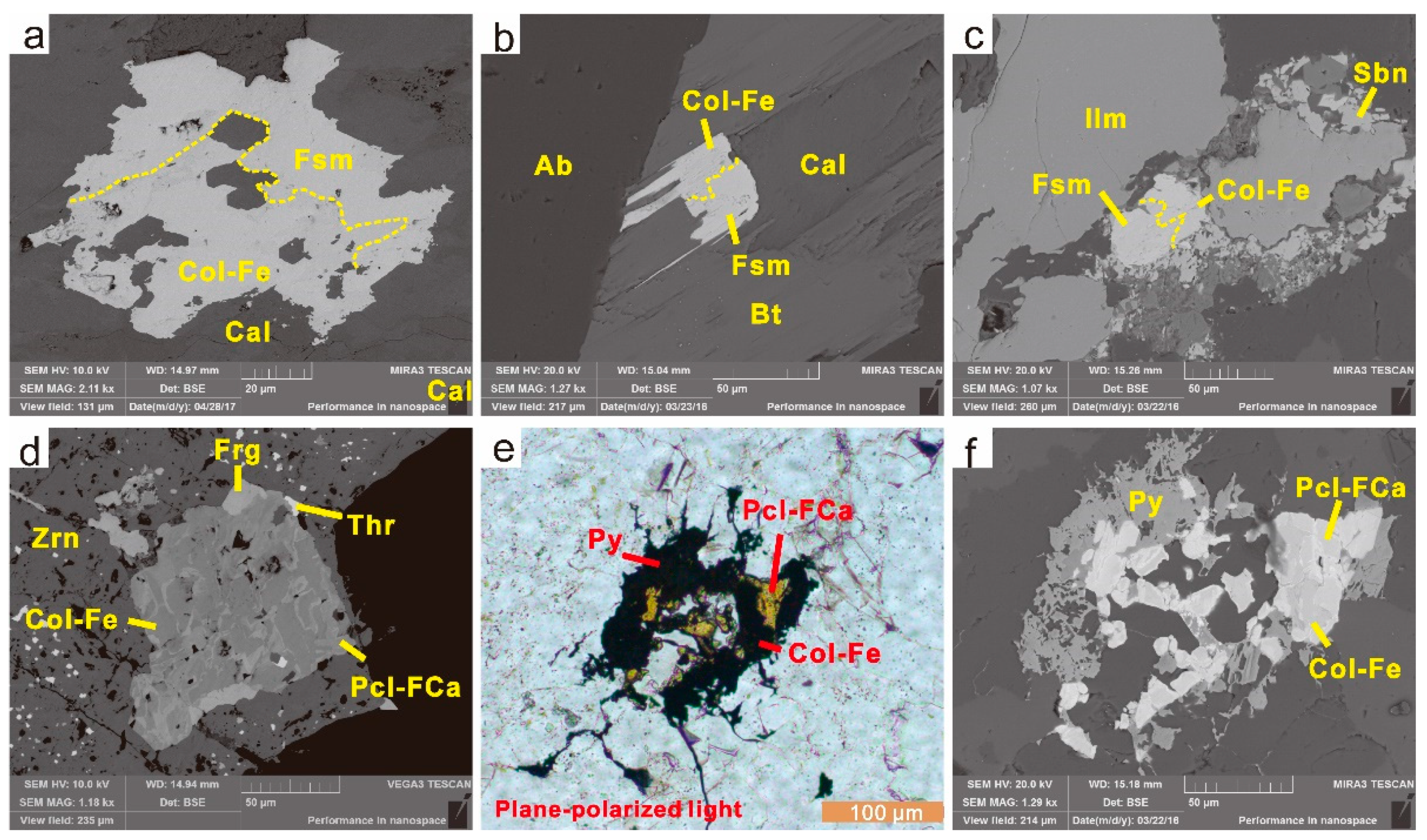
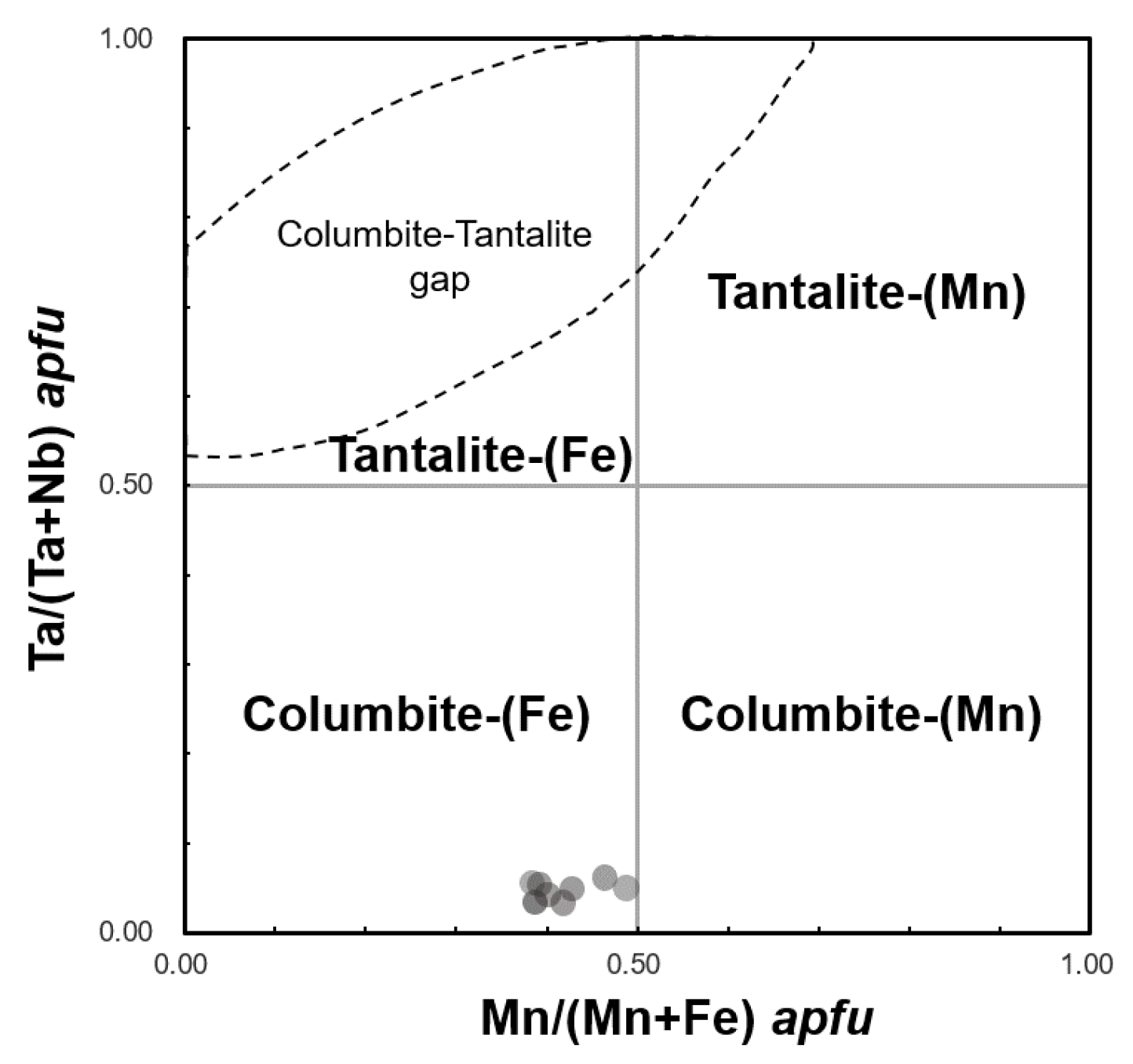
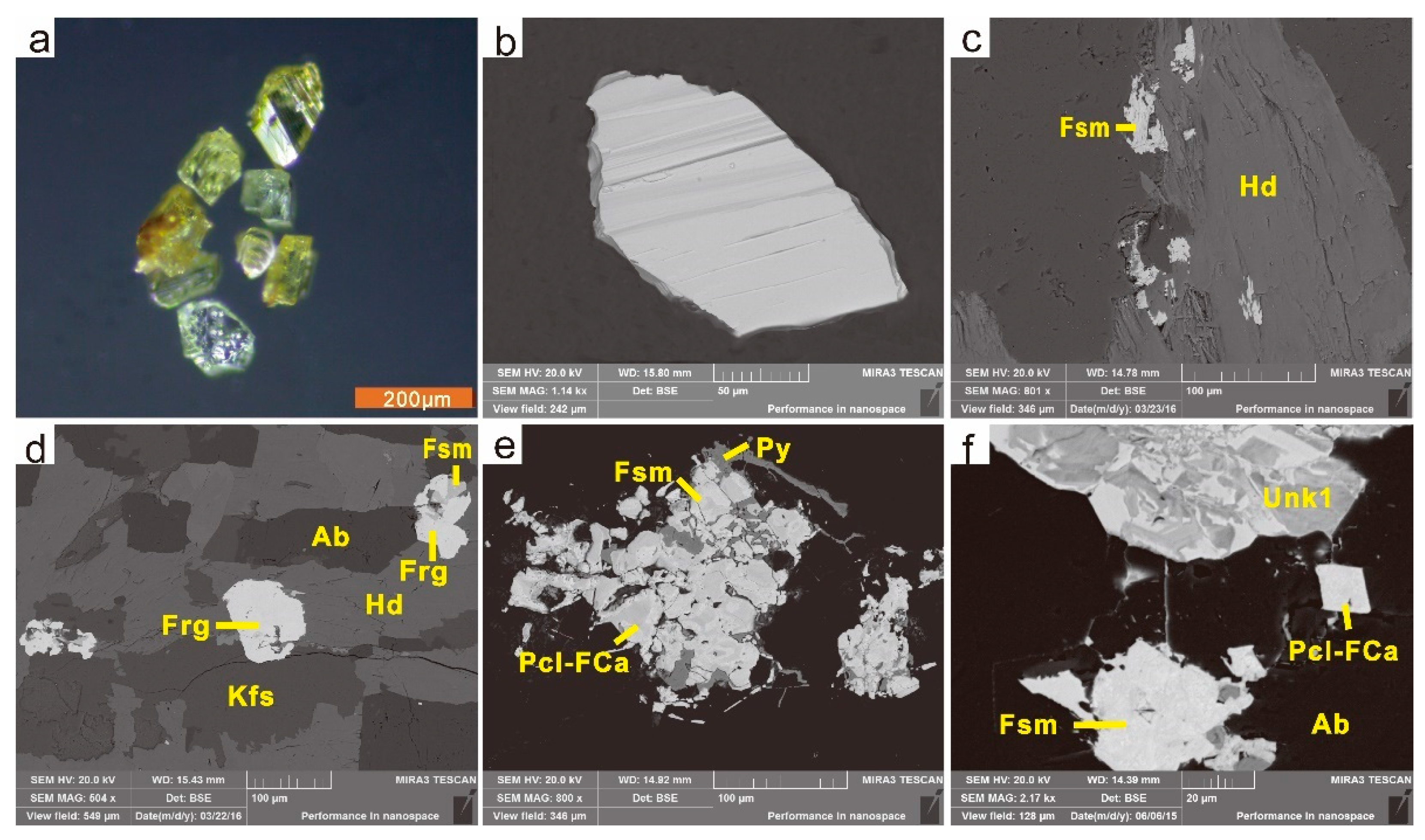
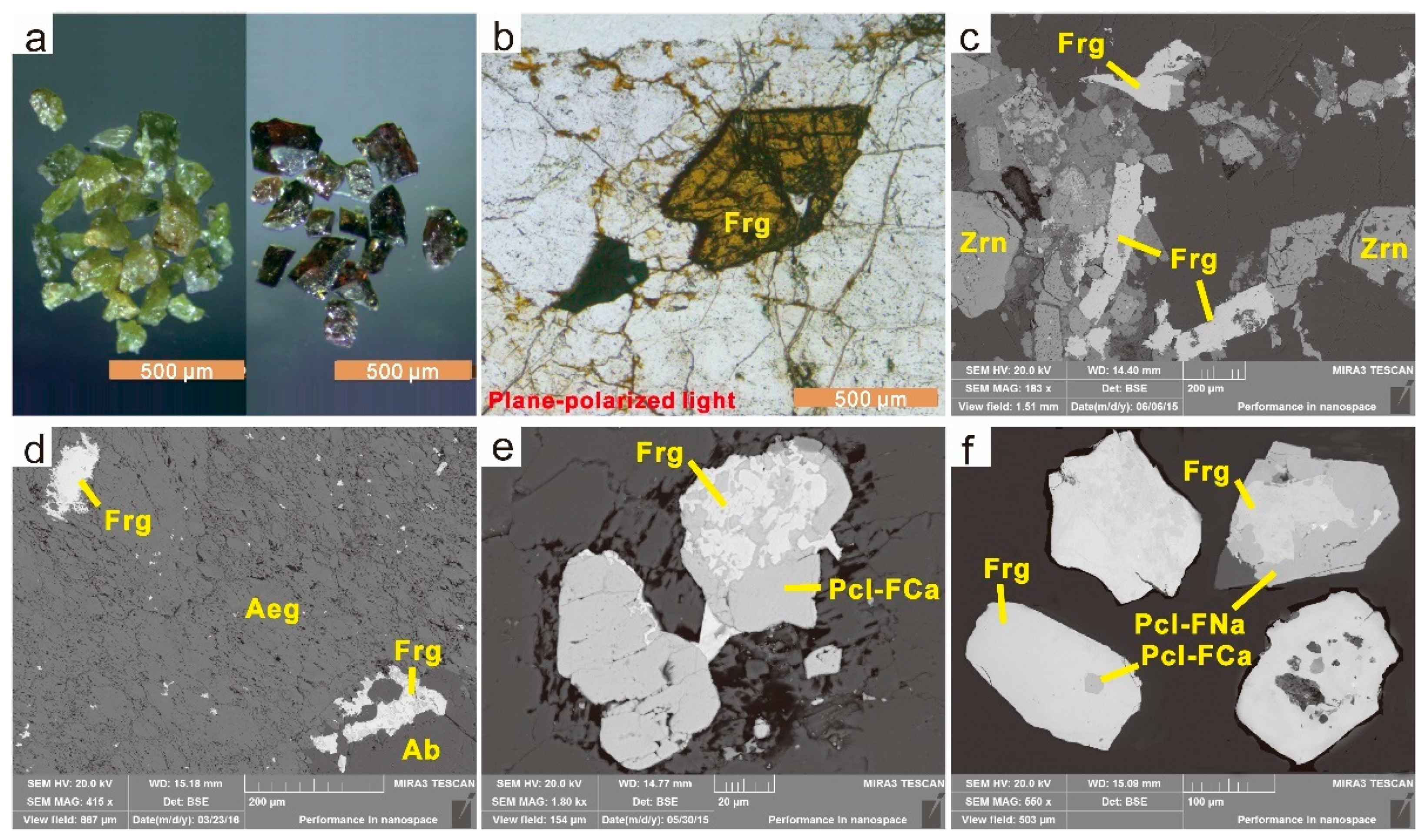
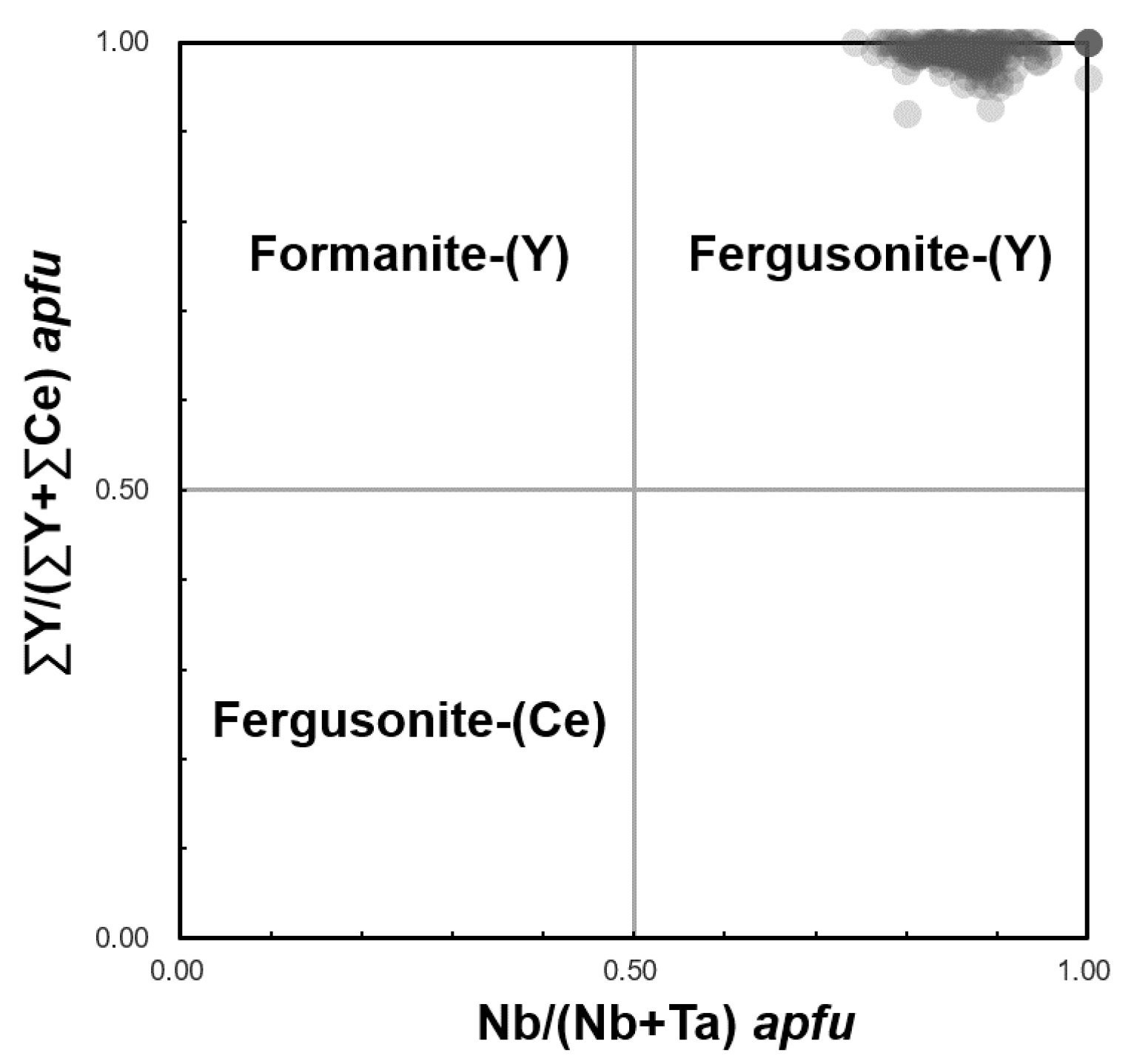
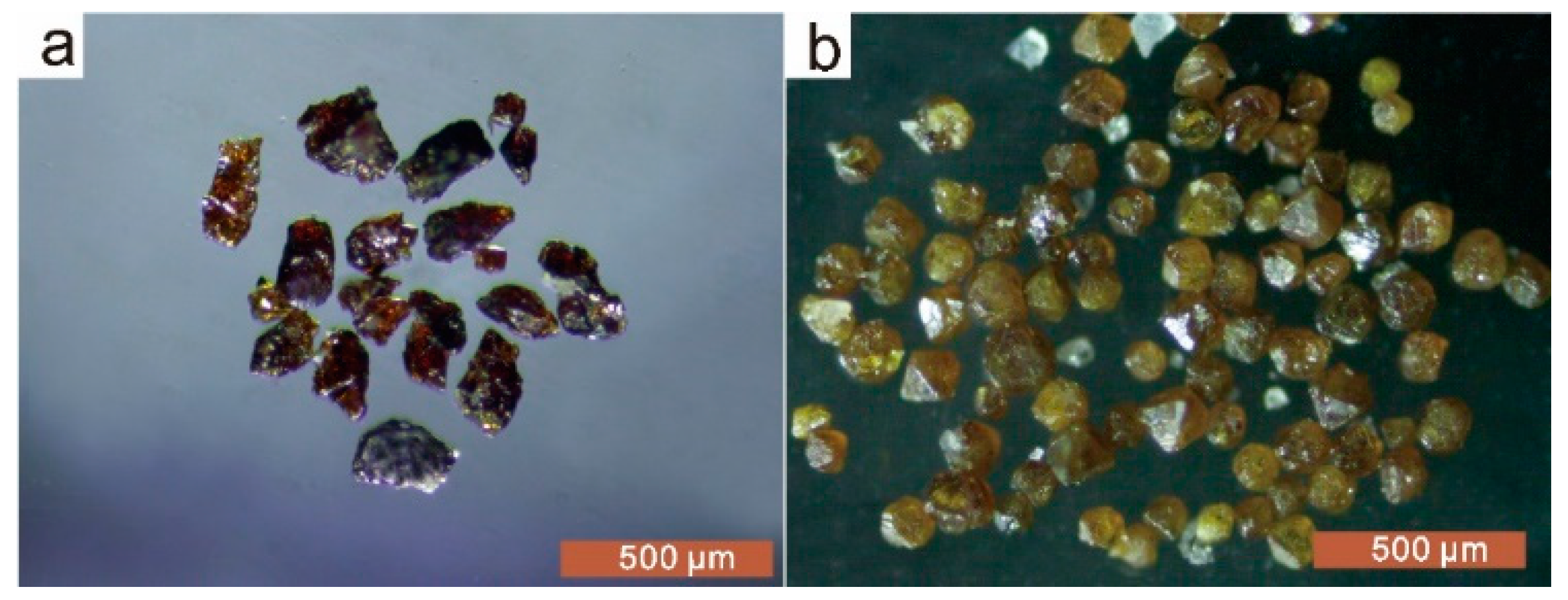
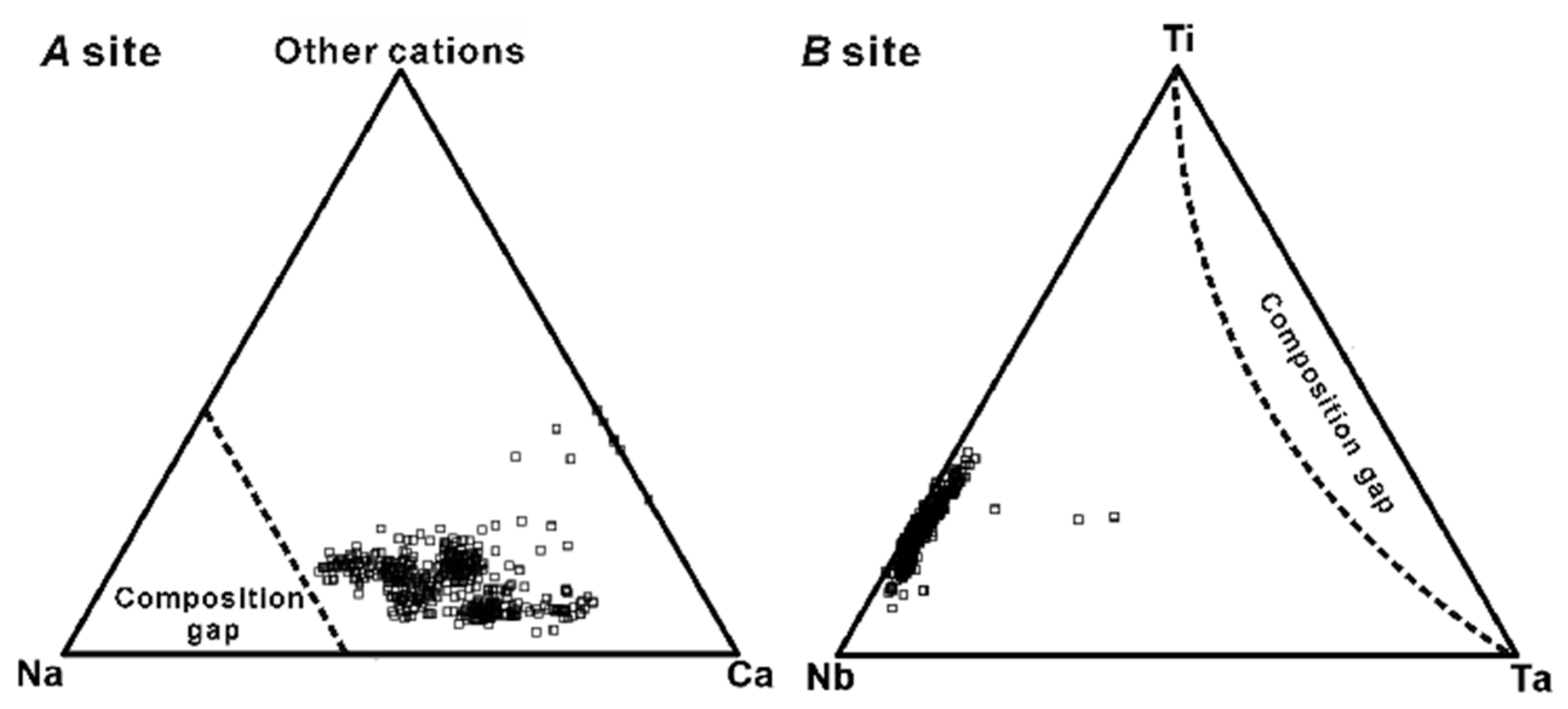
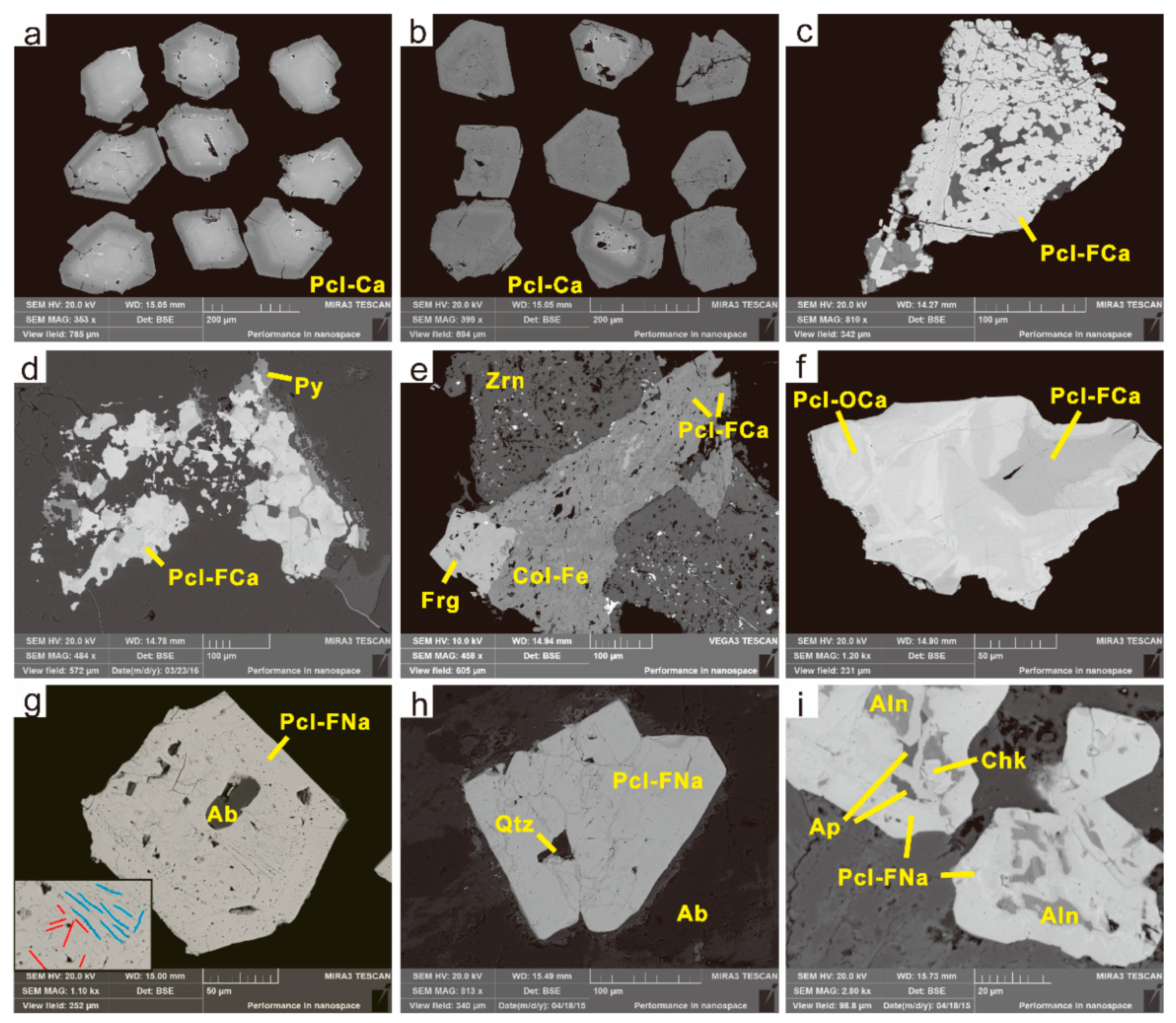
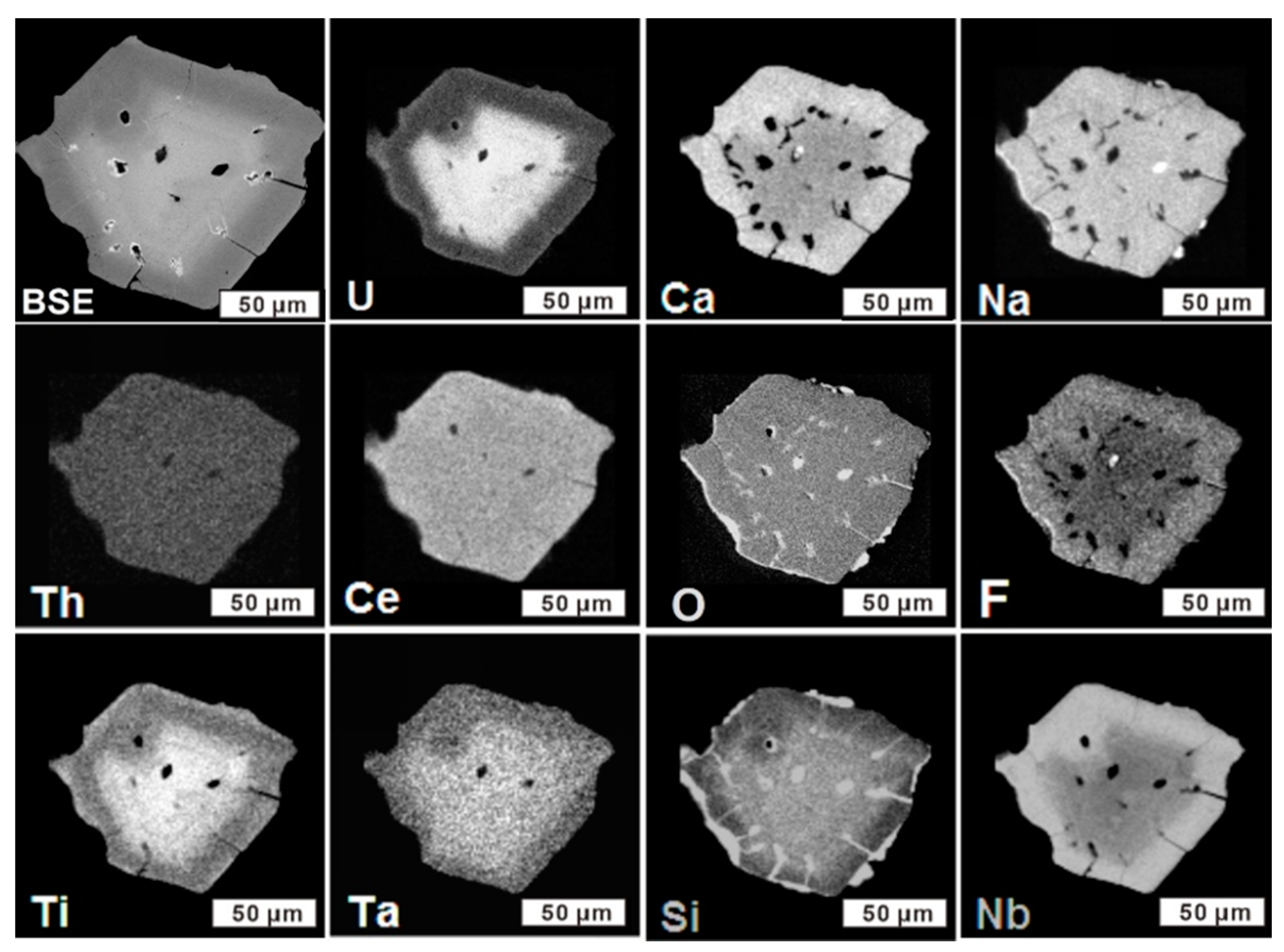
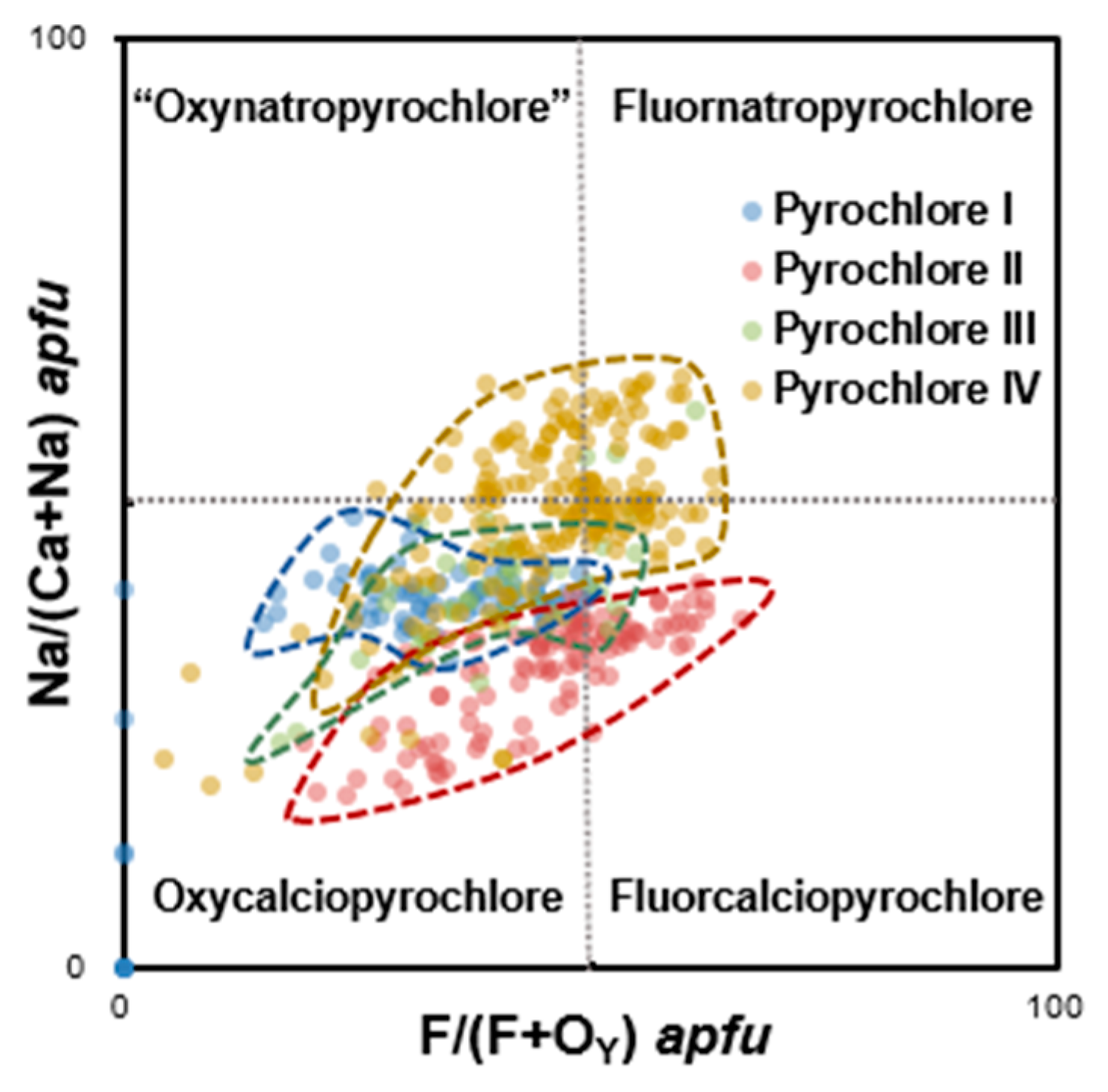
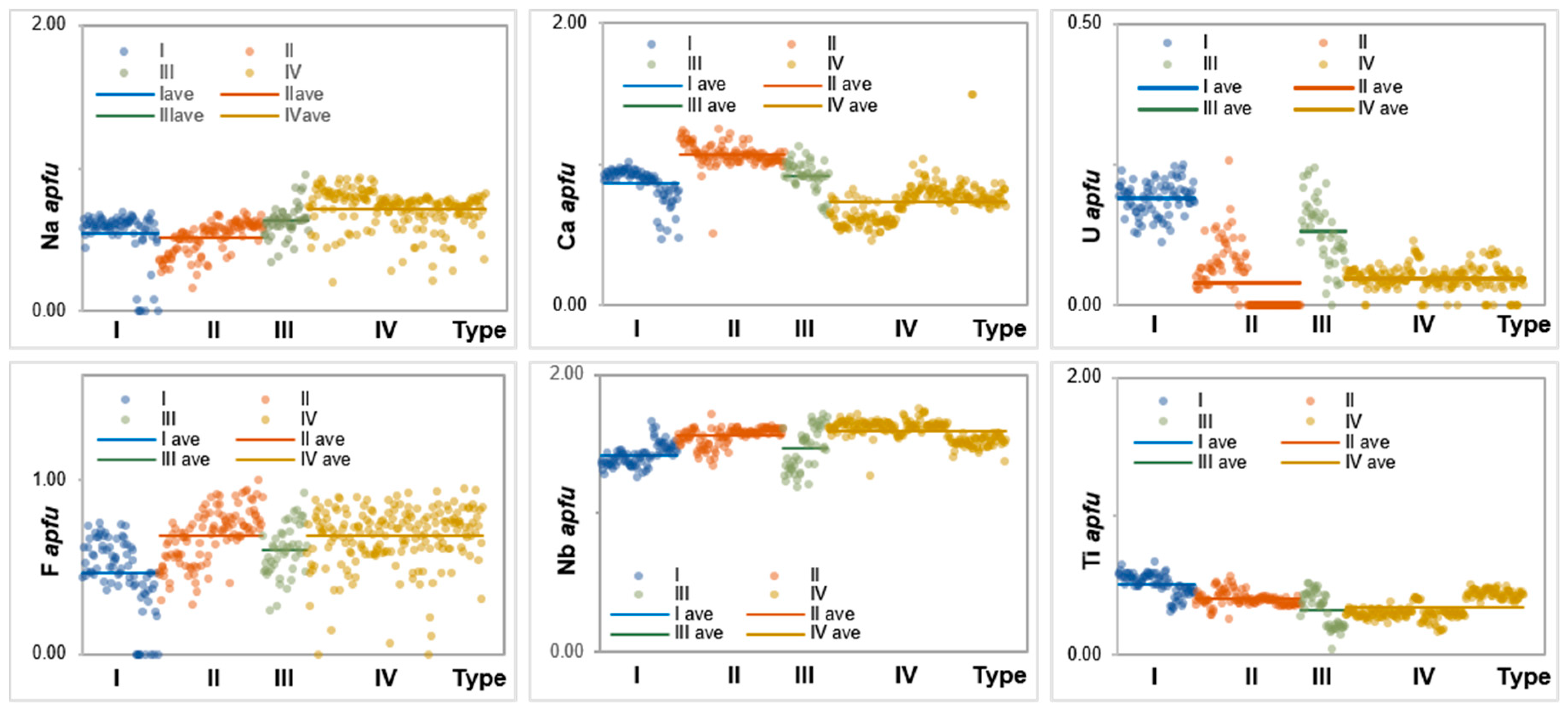


| Component (wt%) | Oxycalciopyrochlore | Fluorcalciopyrochlore | “Oxynatropyrochlore” | Fluornatropyrochlore |
|---|---|---|---|---|
| CaO | 12.37–20.17 | 13.97–20.65 | 8.85–10.94 | 11.69–14.9 |
| Na2O | 1.93–6.77 | 6.24–7.84 | 5.69–7.59 | 7.30–8.64 |
| Nb2O5 | 33.50–55.43 | 43.34–57.69 | 40.76–49.52 | 50.22–56.62 |
| Ta2O5 | 1.08–17.62 | 0.92–13.37 | 2.46–6.23 | 2.84–13.72 |
| TiO2 | 4.73–12.46 | 5.68–8.20 | 6.17–10.41 | 1.87–7.05 |
| ThO2 | 0.25–7.69 | 0.31–4.46 | 0.49–3.82 | 1.12–1.66 |
| UO2 | 0.40–16.34 | 0.04–6.17 | 3.97–15.55 | 0.13–3.00 |
| ∑REE2O3 | 0.00–11.49 | 1.17–8.63 | 9.66–11.33 | 3.36–11.40 |
| F | 1.10–2.28 | 2.53–3.61 | 0.86–2.18 | 2.67–3.19 |
| Component (wt%) | Formula Coefficients (B = 2) | ||||||||||||
|---|---|---|---|---|---|---|---|---|---|---|---|---|---|
| Type | II | III | IV | IV | IV | IV | Type | II | III | IV | IV | IV | IV |
| Sample | XHQ-2 | BC-23 | BC-15 | BC-15 | BC-13 | BC-13 | Sample | XHQ-2 | BC-23 | BC-15 | BC-15 | BC-13 | BC-13 |
| Na2O | 2.02 | 6.99 | 5.88 | 6.27 | 7.51 | 7.72 | Na | 0.26 | 0.87 | 0.79 | 0.85 | 0.98 | 0.98 |
| CaO | 20.30 | 15.69 | 12.67 | 10.73 | 11.62 | 14.52 | Ca | 1.43 | 1.08 | 0.94 | 0.80 | 0.84 | 1.01 |
| MgO | 0.02 | 0.00 | 0.01 | 0.00 | 0.01 | 0.00 | Mg | 0.00 | 0.00 | 0.00 | 0.00 | 0.00 | 0.00 |
| Y2O3 | 1.30 | 0.37 | 0.80 | 1.09 | 1.78 | 0.57 | Y | 0.05 | 0.01 | 0.03 | 0.04 | 0.06 | 0.02 |
| ThO2 | 8.01 | 0.83 | 2.97 | 3.39 | 1.17 | 0.88 | Th | 0.12 | 0.01 | 0.05 | 0.05 | 0.02 | 0.01 |
| Ce2O3 | 3.10 | 3.57 | 3.60 | 5.24 | 5.46 | 4.30 | Ce | 0.07 | 0.08 | 0.09 | 0.13 | 0.13 | 0.10 |
| UO2 | 0.38 | 5.64 | 11.85 | 5.32 | 2.89 | 1.33 | U | 0.01 | 0.08 | 0.18 | 0.08 | 0.04 | 0.02 |
| Pr2O3 | 1.17 | 0.66 | 0.71 | 2.46 | 1.75 | 0.66 | Pr | 0.03 | 0.02 | 0.02 | 0.06 | 0.04 | 0.02 |
| PbO | 0.00 | 0.00 | 0.00 | 0.04 | 0.00 | 0.00 | Pb | 0.00 | 0.00 | 0.00 | 0.00 | 0.00 | 0.00 |
| Nd2O3 | 1.16 | 1.29 | 1.44 | 1.99 | 1.72 | 0.92 | Nd | 0.03 | 0.03 | 0.04 | 0.05 | 0.04 | 0.02 |
| La2O3 | 0.28 | 0.61 | 0.68 | 0.87 | 1.60 | 0.91 | La | 0.01 | 0.01 | 0.02 | 0.02 | 0.04 | 0.02 |
| SiO2 | 0.07 | 0.03 | 0.02 | 0.04 | 0.00 | 0.02 | ∑A-site | 2.00 | 2.20 | 2.15 | 2.10 | 2.20 | 2.20 |
| Si | 0.00 | 0.00 | 0.00 | 0.00 | 0.00 | 0.00 | |||||||
| TiO2 | 11.88 | 8.80 | 10.82 | 7.98 | 6.93 | 4.90 | Ti | 0.59 | 0.43 | 0.56 | 0.42 | 0.35 | 0.24 |
| Nb2O5 | 44.81 | 51.73 | 42.78 | 46.34 | 51.22 | 56.95 | Nb | 1.33 | 1.51 | 1.34 | 1.47 | 1.56 | 1.68 |
| Ta2O5 | 1.21 | 2.73 | 3.09 | 2.87 | 3.04 | 3.87 | Ta | 0.02 | 0.05 | 0.06 | 0.05 | 0.06 | 0.07 |
| Al2O3 | 0.03 | 0.03 | 0.00 | 0.00 | 0.01 | 0.00 | Al | 0.00 | 0.00 | 0.00 | 0.00 | 0.00 | 0.00 |
| MnO | 0.78 | 0.10 | 0.39 | 0.50 | 0.43 | 0.05 | Mn2+ | 0.04 | 0.01 | 0.02 | 0.03 | 0.02 | 0.00 |
| FeO | 0.16 | 0.20 | 0.35 | 0.48 | 0.23 | 0.18 | Fe2+ | 0.01 | 0.01 | 0.02 | 0.03 | 0.01 | 0.01 |
| F | 1.37 | 2.92 | 1.42 | 1.93 | 2.73 | 3.00 | ∑B-site | 2.00 | 2.00 | 2.00 | 2.00 | 2.00 | 2.00 |
| F in Y-site | 0.28 | 0.59 | 0.31 | 0.43 | 0.58 | 0.62 | |||||||
| O = F2 | 0.46 | 1.23 | 0.60 | 0.81 | 1.15 | 1.26 | O in Y-site | 0.57 | 0.40 | 0.58 | 0.46 | 0.41 | 0.39 |
| Total | 97.37 | 100.96 | 98.88 | 96.73 | 98.95 | 99.52 | Species | OCa | FCa | OCa | ONa | FNa | FCa |
Publisher’s Note: MDPI stays neutral with regard to jurisdictional claims in published maps and institutional affiliations. |
© 2021 by the authors. Licensee MDPI, Basel, Switzerland. This article is an open access article distributed under the terms and conditions of the Creative Commons Attribution (CC BY) license (https://creativecommons.org/licenses/by/4.0/).
Share and Cite
Xue, Y.; Sun, N.; Li, G. Evolution of Nb–Ta Oxide Minerals and Their Relationship to the Magmatic-Hydrothermal Processes of the Nb–Ta Mineralized Syenitic Dikes in the Panxi Region, SW China. Minerals 2021, 11, 1204. https://doi.org/10.3390/min11111204
Xue Y, Sun N, Li G. Evolution of Nb–Ta Oxide Minerals and Their Relationship to the Magmatic-Hydrothermal Processes of the Nb–Ta Mineralized Syenitic Dikes in the Panxi Region, SW China. Minerals. 2021; 11(11):1204. https://doi.org/10.3390/min11111204
Chicago/Turabian StyleXue, Yuan, Ningyue Sun, and Guowu Li. 2021. "Evolution of Nb–Ta Oxide Minerals and Their Relationship to the Magmatic-Hydrothermal Processes of the Nb–Ta Mineralized Syenitic Dikes in the Panxi Region, SW China" Minerals 11, no. 11: 1204. https://doi.org/10.3390/min11111204
APA StyleXue, Y., Sun, N., & Li, G. (2021). Evolution of Nb–Ta Oxide Minerals and Their Relationship to the Magmatic-Hydrothermal Processes of the Nb–Ta Mineralized Syenitic Dikes in the Panxi Region, SW China. Minerals, 11(11), 1204. https://doi.org/10.3390/min11111204






